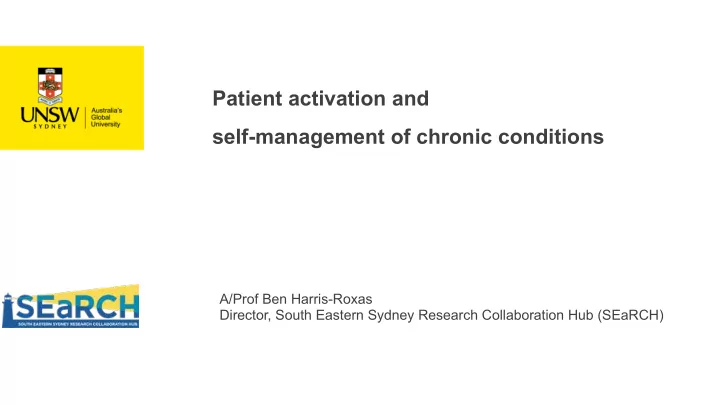

Patient activation and self-management of chronic conditions A/Prof Ben Harris-Roxas Director, South Eastern Sydney Research Collaboration Hub (SEaRCH)
What is patient activation? Knowledge Stages of activation: Skills 1. Believe their role in their own Confidence care is important 2. Learn and develop confidence to manage your own to act on their own behalf health and care 3. Actually acting 4. Reaching the point of acting even under stress Source: Hibbard, Judith; Stockard, J; Mahoney, ER; Tusler, M (August 2004). "Development of the Patient Activation Measure (PAM): Conceptualizing and measuring activation in patients and consumers". Health Services Research. 39 (4): 1005–10026.
Why does it matter? Patient activation has been shown to predict: • medication adherence • ED presentations • hospitalisations.
What is the Patient Activation Measure? • Gauges knowledge, skills and confidence • Segments consumers four activation levels.
Rationale • PAM has been widely used as an outcome measure • Less evidence about the use of PAM as a tool to tailor care • Testing the feasibility of implementing the PAM as a tailoring tool
The study Feasibility study of the use of the PAM to improve quality of care. Three phases 1. Scoping literature review on use of PAM to improve quality of care. 2. Retrospective record audit investigating use of the PAM in SESLHD. 3. Pilot study to test use of the PAM as a tool to improve the quality of care for patients with chronic conditions.
Phase 1 Results: How has PAM been used? 1 . As a tool for tailoring care • Care planning and self management: goal setting, coaching, motivational interviewing • Supporting transition from hospital to home • Hospital readmission prevention programs 2. Risk profile assessment for population groups • Clinical indicators plus PAM scores • Stratification to tailored interventions
Phase 2 Results: Retrospective record audit • 61% (n=118) completed the program (pulmonary rehab) • Mean (SD) baseline PAM score was 60.5 (15.7) • PAM score improved to 65.4 (15.5) at program completion • Anxiety, lung information needs and QOL were associated with patient activation McNamara, Renae J., et al. "Knowledge, Skill, and Confidence in People Attending Pulmonary Rehabilitation: A Cross-Sectional Analysis of the Effects and Determinants of Patient Activation." Journal of Patient Experience 6.2 (2019): 117-125.
Phase 3: Pilot study of the use of PAM for tailoring Method Baseline Intervention Follow-up: period 3-4 mths Patient survey: Patient demographics, health X X information, PAM, Partners in Health scale Team interviews X Clinician survey: CS-PAM tool X Audiotapes of patient-clinician consultations X Patient interviews X Monthly team reports X X X
Summary of Phase 3 qualitative findings • Tactical and practical challenges in using PAM • Many issues are similar to those faced in adopting new practices (NPT) • Making PAM meaningful within a clinical encounter is not straightforward
Summary of Phase 3 patient survey findings Patient Activation and Measure and Partners in Health scores at assessment and 3 months follow up 3 month Scale Assessment Significance follow-up (number) (SD) (SD) PAM 13 63.04 68.16 p=0.002* (n=70) (13.79) (15.59) PIH 79.19 81.97 p=0.042* (n=62) (10.76) (9.37) *paired t-test
Summary of Phase 3 patient survey findings Change in individuals’ PAM scores between However when individuals’ Change in individuals’ PIH scores between assessment and follow up assessment and follow up by change in PIH scores PAM scores were compared with changes in their PIH scores no significant correlation was found r = .207, n=72, p=0.081 Change in individuals’ PAM scores between assessment and follow up
Summary of findings • Although PAM and PIH scores were associated, a change in PAM did not predict change in PIH. • Suggests that PAM and PIH may have been associated due to other unidentified factors, such as health literacy, education, or health status. • There’s more at play here than a simple conceptualisation of activation.
So what? Barriers and facilitators • Critical role of clinicians – linked to perceptions of PAM and its value • Tailoring care requires high level skills • Competing workplace demands, clinical practices, routines • Ease of understanding the PAM questions • Challenges of calculating scores in clinical settings
Reflections • This is a small study • Implementing the PAM as a tailoring tool is a work in progress • Challenges that were more prominent than expected: o Language and literacy barriers o Unwell patients o Integrating the PAM into established programs • Could enable more efficient targeting of resourcing to patients with lower activation – but this requires an explicit discussion about equity
Acknowledgements SESLHD Collaborators Integrated Care Unit Units Participating Cardiac rehabilitation, Prince of Wales Hospital Respiratory coordinated care, Prince of Wales Hospital Integrated Rehabilitation and Enablement Program (IREaP), Uniting War Memorial Hospital Investigators A/Prof Ben Harris-Roxas (SEaRCH), A/Prof Sarah Dennis (USyd), Rachael Kearns (SEaRCH), Tom Chapman (SESLHD), Prof Mark Harris (UNSW), Dr Renae McNamara (SESLHD, Phase 2)
Recommend
More recommend